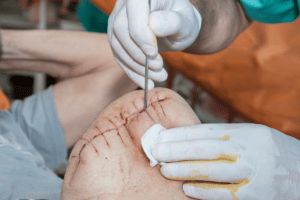Seamen are at high risk of losing limbs and amputation, unfortunately, as most aspects of maritime work are high-risk. From chains, hatches, winches, and more, seaman work around a multitude of equipment that can quickly cause injuries. In addition, an unseaworthy vessel and negligent employers place workers at even higher risks for injuries. Safety should always be first priority, especially in what’s already considered a job that comes with extremely high risks.

Negligence and Lost Limbs
When an employer or vessel owner fails to provide the proper safety standards for workers which can result in lost limbs, one of the following typically plays a large part in the accident:
- The seamen were working with defective and malfunctioning equipment
- Adequate training was not provided, including procedural, safety, and equipment training
- Lack of sufficient navigation planning
- Navigation collisions
- Broken equipment
The medical costs associated with lost limbs and amputations are extremely high. In fact, according to a 2007 study performed by the Journal of Bone and Joint Surgery, amputation costs alone can exceed more than $500,000 for lifelong care.
Treatment for Lost Limbs and Amputation
Recovering from lost limbs is not only physically painful, but difficult to mentally deal with. Therefore, treatment consists not only of the physical injuries but the mental and emotional injuries as well.
One of the biggest physical hurdles with lost limbs is known as phantom limb sensation, meaning that victims still feel the pain as if the lost limb is still there. Phantom limb sensations is the physical feeling that the lost limb is still attached, and in turn causes cramping, burning, and stinging. Although scientists have still not determined why phantom limb sensations occur, it’s theorized that it comes from brain reorganization. The brain is still accustomed to having the limb and any sort of pressure on the area will trigger burning and cramping sensations. Some people report feeling shock-like sensations as well. Treatment for phantom limbs consists of several different options, including:
- Wrapping the area up in a warm towel, applying a heating, and alternating with cool compresses
- Practicing mental relaxation exercises when the pain occurs
- Performing muscle tightening exercises in the lost limb area
- Hot showers and baths
- Professional massages in the lost limb area
- Different forms of therapies, which can include acupuncture, biofeedback, and chiropractic care
- Regular use of natural supplements and vitamins, such as potassium, calcium, magnesium, and vitamins A, E, and B12
Healthy lifestyle habits is a must when dealing with an amputation or lost limb. A diet full of leafy vegetables along with regular exercise will help to control additional medical conditions that sometimes surface with lost limbs. In addition, stress-relieving techniques are highly recommended to help with the emotional pain. Stress-relieving techniques can include meditation, counseling, peer support, and yoga.
In addition, physical therapy should become a long-term part of your lifestyle. Physical therapy can increase muscle tone and coordination as well as help provide better circulation in the residual limb area. Although physical therapy can be difficult, long work, the advantages are extremely beneficial. Be certain to speak with your healthcare provider concerning the right type and amount of physical therapy for you.
Compensation and Negligence
If the lost limb/amputation occurred because of the negligence of an employer, vessel owner, or another party, it’s important to understand your legal rights under maritime law. Living with a lost limb takes emotional and physical tolls, but it is also quite expensive, and the costs last a lifetime. It’s crucial to to understand general maritime law, including the Jones Act. For more information, visit our Jones Act Lawyer page.
Sources: